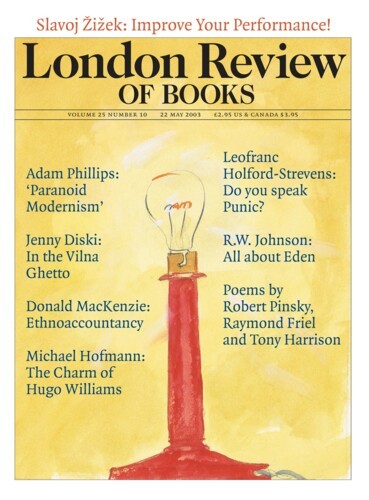The first of the summer blockbusters is with us. For weeks, Carrie-Anne Moss has glowered beautifully from posters on the Underground, ‘21.05.03’, the release date of The Matrix Reloaded, stamped across her coat. Even cooler, a poster of incomprehensible green computer code resolves holographically into Keanu Reeves glowering beautifully as you walk past. I can’t wait to see the movie; the trailer, downloadable from whatisthematrix.warnerbros.com, is awesome. The premise of the trilogy is that reality as we know it is a computer-generated illusion: our bodies are all lying in amniotic tanks, batteries for the machines that actually rule the world; our minds plugged into the matrix to keep us alive (no, the science doesn’t withstand much scrutiny). In the story so far, our hero, Neo, endearingly played by the ever baffled Reeves, learns the truth courtesy of a mentor dude known as Morpheus (Laurence Fishburne) and a sexy karate princess called Trinity (Moss). He goes on to fight the forces of evil, chief among them a certain Agent Smith (Hugo Weaving), who is endowed with irresistible menace, and in the process undergoes apotheosis, emerging finally as ‘the One’, to nobody’s very great surprise. All of which is of course guaranteed to please the crowds. The style, stunts and special effects, on the other hand, were so far ahead of the game in 1999 that they rewrote the rules of how a certain kind of movie should be made, and are sure to delight the crowds even more. For the sequels to live up to The Matrix will be difficult, and it’s small wonder that both were filmed together, part three to be released in November: to be that different three times in a row would surely be impossible – just look what happened to Star Wars.
Star Wars, along with Jaws, is regularly cited, not least by David Thomson, as the film that ‘killed the movies’. Glenn Kelly’s answer, in his introduction to A Galaxy Not So Far Away: Writers and Artists on 25 Years of ‘Star Wars’ (Allison and Busby, £9.99), is: ‘Get over it, Dad.’ This selective quotation slightly misrepresents Kelly – he’s a fan of Thomson’s, and is far from blind to the many inadequacies of Star Wars and its sequels – but his point is a fair one. The essays in the collection do not belong in the upper order of film criticism, nor should they: Star Wars isn’t that kind of film. But to many people of (under) a certain age (and culture), life is unimaginable without it. I was baptised the month Star Wars was released in America, and when I was a little boy, a significant chunk of my imaginative life was dominated by the franchise. I had all (well, not all: but how I wanted all) the plastic figurines and concomitant gadgetry; I had a woefully disappointing Darth Vader costume; I was taken to Basingstoke’s largest department store to see Darth Vader (shouldn’t I have been frightened? Or was it too obvious that under the mask ‘Darth Vader’ was probably the same man from the storeroom who usually played Santa Claus?); my best friend would come to my house to play ‘Star Wars’ in secret, anxious about the scorn his older brothers might heap on him. The weirdest thing of all, however, is that I didn’t actually see any of the films at the cinema until the digitally rejigged versions were released in the late 1990s: in the merchandising of Star Wars, John Seabrook writes in NoBrow (2000), ‘dreams were being spun into desire, and desire into product.’ And then one day I got tired of it all and gave my toys away to a younger boy who lived down the road.
A Galaxy Not So Far Away opens with a brilliant and sad essay by Jonathan Lethem, called ‘13, 1977, 21’, about how he went to see Star Wars 21 times in the summer of 1977 (he was 13), when his mother was gravely ill. ‘I think I came to hate a lot of the film,’ he writes, ‘but I couldn’t permit myself to know it. I even came, within a year or so, to hate the fact that I’d seen the movie 21 times.’ Tom Carson’s excellent contribution is concerned with the movie’s proto-Reaganite, even neo-fascist instincts. ‘Jedi über Alles’ ends with the observation that ‘it’s as a fairytale projection of how Americans view the world and their own role in it that Star Wars is most fascinating . . . The galaxy’s only function seems to be to provide an arena for righteous derring-do, and its non-human inhabitants are, first and foremost, disposable.’
Todd Hanson, in ‘A Big Dumb Movie about Space Wizards’, writes about the gross disappointment that was Star Wars Episode I: The Phantom Menace. ‘We waited a good half our lives for it to come out, and when it did, it was as if the destructive power of a fully operational battle station had been unleashed on the childhood hopes and dreams . . . of pretty much a whole generation.’ But it seems to me he was looking in the wrong place: what he, they, we were waiting for was, in fact, The Matrix.
Send Letters To:
The Editor
London Review of Books,
28 Little Russell Street
London, WC1A 2HN
letters@lrb.co.uk
Please include name, address, and a telephone number.

